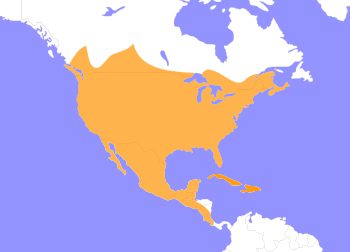Dove
Zenaida macroura
Doves, also known in North America as the mourning dove or the rain dove. It is one of the most abundant and widespread of all North American birds. It is also a leading gamebird, with more than 20 million birds (up to 70 million in some years) shot annually in the U.S., both for sport and for meat. Its ability to sustain its population under such pressure is due to its prolific breeding; in warm areas, one pair may raise up to six broods of two young each in a single year.
Mourning doves are light grey and brown and generally muted in color. Males and females are similar in appearance. The species is generally monogamous, with two squabs (young) per brood. Both parents incubate and care for the young. Mourning doves eat almost exclusively seeds, but the young are fed crop milk by their parents.
The mourning dove is a medium-sized, slender dove averaging 12in in length. Adult mourning doves weigh 4.0–6.0 oz, usually averaging around 4.5 oz. Their wings are elliptical and broad, and they have a small rounded. Its tail is long in comparison to the rest of its body, it has a tapered shape, getting smaller to meet at a point. Mourning doves have perching feet, with three toes forward and one reversed. The legs are short and reddish colored. The beak is short and dark, usually a brown-black hue. They occupy a wide variety of open and semi-open habitats, such as urban areas, farms, prairie, grassland, and lightly wooded areas. They avoids swamps and thick forest. The species has adapted well to areas altered by humans, they will commonly nest in trees in cities or near farmsteads.

The geographic range of the Native American dove ranges across warm lands of North America and South America.
HABITAT -They inhabit urban areas, farms, prairie, grassland, and lightly wooded areas across the Americas.
DIET -They are mainly herbivorous, seeds make up 99% of their diet. They occasionally eat snails or insects.
FUN FACT -They have a short life span of 1.5 years, the longest living dove is 19.3 years old.
SOCIAL BEHAVIOR -They will form monogamous mating pairs, and spend most of their time together.
ACTIVITY -They are diurnal being most active during the day and resting during the evening.
PREDATORS -Predators include birds of prey such as falcons, hawks, and rat snakes.
SIZE -They are a medium sized bird averaging 12in. Adult mourning doves on average weigh around 4.5 oz.
RELATIVES -There are many species of dove belonging to the family Zenaida, such as the Socorro dove and Eared dove.
CONSERVATION -Doves are categorized as LC (Least Concern) species by the IUCN.
Cub Creek Animal Care Information
Housing - We house our birds in one of our indoor flight enclosures.. Our enclosures are large rooms filled with trees! They are the newest renovation to the jungle building! Housing our birds in flight enclosures rather than small cages allows for more socialization and room to let their wings stretch! They have many branches all over the enclosure to perch on and fly to and fro. There is also a window where they can observe what is going on outside. Our dove lives with cockatiels and budgerigars.
Diet - These birds are fed ZuPreem small bird pellets, which includes everything they need to be healthy and receive all the necessary nutrients. They are also given bird salad, a mix of diced apples, shredded sweet potato, and chopped lettuce. Fresh water is given daily.
Enrichment - Their multi-species enclosure (with chinchillas and other bird species) provides enrichment through daily interactions and get to play with toys that are made for the others. Campers can use cardboard, twine, and pretty much anything we can find to make hanging toys that can have food hidden in them or just used to swing on!

